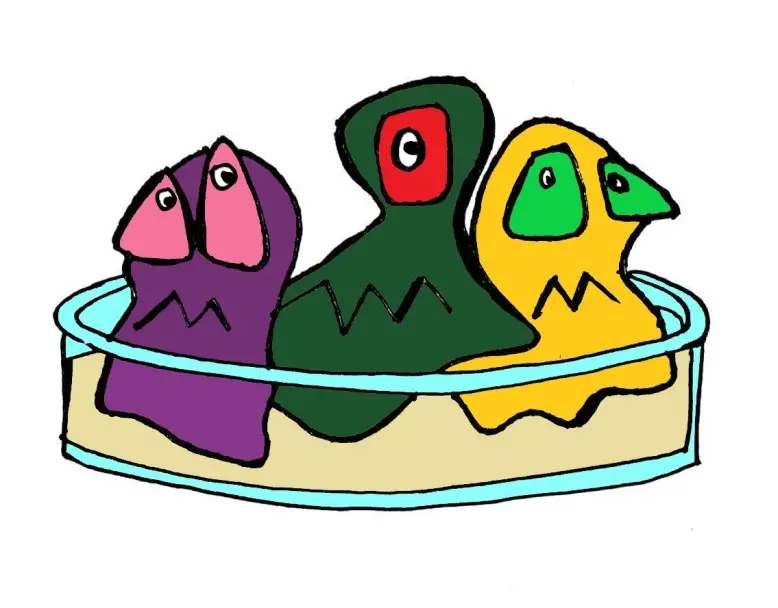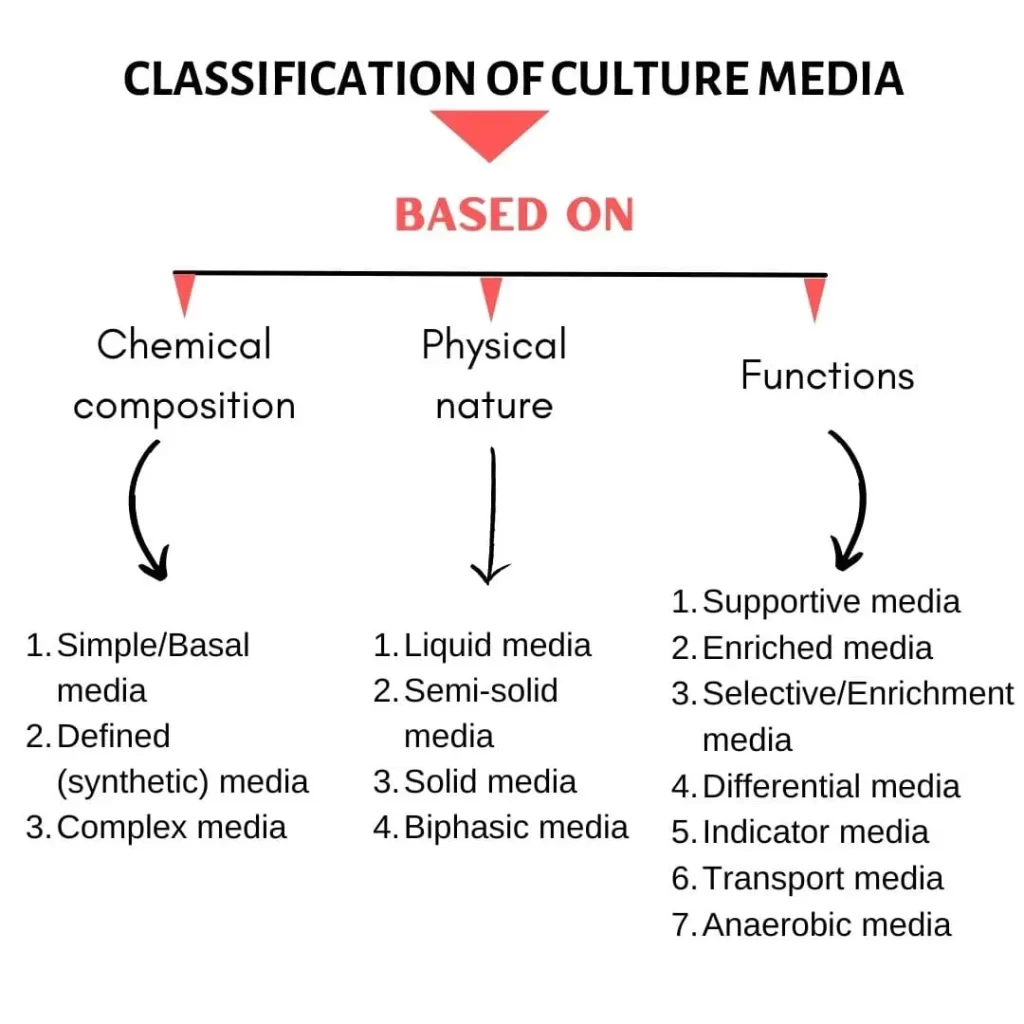
Bacterial Culture Medica is one of the most important topic in the field of Microbiology.
In this post we will talk about,
Basic introduction, History, Characteristics, Composition, Types and Classification of Bacterial culture media.
How do you study something that you can’t see?
You place it under the microscope to observe right!
But certain microorganisms (e.g. bacteria) do not have too many identifying features.
So, you grow large populations of them (i.e. culture them).
You observe the behavior of that population under various environmental conditions.
Table of Contents
ToggleIntroduction
To study of microorganisms, we need to isolate them from their natural habitats and grow them in the laboratory on synthetic media.
In this laboratory exercise you will learn about composition and types of culture media and how different types of media can be used to study the properties of bacteria.
[Note: words with ( * ) are particularly defined at the end of this post.]
What is culture media?
A culture medium is a solid or liquid mixture of chemicals that can support the growth of microorganisms.
It should contain a source of carbon and energy (Nutrients prepared for microbial growth).
Microbiologists use culture media to isolate and to identify the bacteria, to find out their metabolic properties, and storage of microorganisms.
Inoculum: Microorganisms that are inserted into a culture medium to initiate growth are called inoculum (Suspension of microorganisms).
Inoculation: Introduction of microbes into culture medium (a procedure).
Culture: Microbes growing on a culture medium.
- A pure culture contains only one species or strain.
- Mixed culture contains several species.
- Contaminated culture contains unwanted species of organisms.
Colony: Visible growth of microbes on the surface of a solid medium.
Let’s revise the history
Louis Pasteur used simple broths* made up of urine or meat extracts.
Robert Koch studied the importance of solid media and used potato pieces to grow bacteria.
Before the use of agar, attempts were made to use Gelatine as solidifying agent.
Gelatine had some limitations; it existed as liquid at normal incubation temperatures (35-37 °C) and was digested by certain bacteria.
Characteristic of ideal Culture Medium
- Must give a satisfactory growth from a small inoculation.
- Should promote a rapid growth.
- Should be easy to prepare.
- Should be reasonably cheap.
- Should be easily reproducible.
Composition of culture media
An artificial culture medium must provide all the nutritional requirements that a microorganism gets in its natural environment.
Any culture medium must contain:
- A source of energy.
- Sources of carbon, nitrogen, sulphur, phosphorus.
- Minerals, e.g., Ca2+, Mg2+, Na+.
- Vitamins and growth factors.
- Water
- Essential for the growth of all the microorganisms.
- Must be free from any chemicals which inhibit bacterial growth.
- Sodium chloride & other electrolytes (potassium, magnesium, iron, calcium)
- NaCl2 is essential ingredient of most culture media.
- Sulphates are required as a source of sulphur.
- Phosphates are needed as a source of phosphorus.
- Peptone (water-soluble)
- Obtained from the digestion of protein materials with proteolytic enzymes.
- Contains a mixture of amino acids, carbohydrates, mineral salts and polypeptides.
- Meat & yeast extract
- Used to enrich media.
- It contains protein degradation products, carbohydrates, inorganic salts and some growth factors.
- Carbohydrates (Simple; glucose, sucrose, maltose. & Complex; glycogen, glycerol).
- Provide bacteria with carbon and energy.
- Helps to differentiate the bacteria.
- Agar
- A complex polysaccharide.
- Extracted from a variety of seaweed (red marine algae).
- Used as a solidifying agent.
- Only a few microbes can degrade agar, so it remains solid.
- Agar liquefies at about 100°C and at sea level it remains liquid until the temperature drops to about 40-45°C .
Types of media
There are two major types of growth media
1) Cell culture: They are used for specific types of cells derived from plants or animals.
2) Microbiological culture: They are used for growth and preservation of microorganisms, such as bacteria or yeast.
Classification of culture media

Culture media are classified in three groups as follows:
A. Based on chemical composition
1) Simple media/ Basal media
2) Defined (synthetic) media
3) Complex media.
B. Based on physical nature
1) Liquid media
2) Semi-solid media
3) Solid media.
4) Biphasic media.
C. Based on functions
1) Supportive media
2) Enriched media
3) Selective media & Enrichment media
4) Differential media
5) Transport media
6) Indicator media
7) Anaerobic media.
BASED ON CHEMICAL COMPOSITION
1) Simple media/ Basal media
- Most commonly used in routine laboratory diagnostic procedures.
- Supports most non-fastidious* bacteria.
- Used for primary isolation of microbes.
- Peptone water, nutrient broth and nutrient agar are considered as simple media.
2) Defined (synthetic) media
- Exact chemical composition is known.
- It must contain organic compounds that serve as a source of carbon and energy.
- Widely used in research, often to know exactly which substance the microorganism is metabolizing.
3) Complex media
- A media that contains some ingredients of unknown composition.
- Often needed when chemical requirements of a particular microorganisms are unknown.
- Used for fastidious microbes and organisms with complicated nutritional needs.
- Most complex media contain peptones, meat extracts and yeast products.
- Examples- Nutrient broth, Tryptic soy broth, MacConkey agar.
BASED ON PHYSICAL NATURE
1) Liquid media
- Contains no agar.
- Used to prepare inoculum especially when numbers in the inoculum is suspected to be low.
- Liquid media is used when a large number of bacteria have to be grown.
- Known as nutrient broths.
- Bacteria grow uniformly with producing general turbidity.
- Mixed organisms cannot be separated.
- Properties of bacteria are not visible in liquid media and presence of more than one type of bacteria cannot be detected.
2) Semi-solid media
- Contains 0.5% agar.
- Soft consistency.
- Used to demonstrate motility of bacteria.
- Motile and non-motile organisms can be separated.
3) Solid media
- Most commonly used solidifying agent is Agar.
- Used to separate and isolate mixed bacteria.
- Bacteria can be identified on the basis of their colony characters.
- Colony morphology, pigmentation, haemolysis etc can be observed.
- Examples are Nutrient agar and Blood agar.
4) Biphasic media
- Sometimes, a culture setup contains both liquid and solid medium in the same bottle, this is known as biphasic medium.
- The inoculum is added to the liquid medium and when subcultures are prepared, the bottle is simply tilted to allow the liquid to flow over the solid medium.
- Agar, egg yolk and serum can be used to solidify culture media, while serum and egg yolk are normally liquid, they can be made solid by coagulation using heat.
BASED ON FUNCTIONS
1) Supportive media
- They support the growth of many microorganisms.
- Tryptic soy broth and tryptic soy agar are their examples.
- Called as general-purpose media.
2) Enriched media
- When blood, serum, egg yolk and other nutrients are added to supportive media to encourage fastidious microbes, it is called Enriched media.
- Blood agar, chocolate agar, Loeffler’s serum slope etc are the enriched media.
3) Selective media & Enrichment media
- Selective media allows the growth of particular microorganisms while suppresses the growth of others.
- Because some bacteria present in small numbers can be missed especially when others are present in large numbers.
- Enrichment media is similar to selective media but designed to increase the numbers of desired organisms to detectable levels.
- Usually culture is in liquid form which provides favourable environment and nutritional requirements.
4) Differential media
- Makes it easier to differentiate desired colonies from others growing on the same plate.
- Media is designed in such a way that can differentiate bacteria on the basis of their colony colours and even gives tentative identifications.
- Blood agar is both differential medium and an enriched media.
- MacConkey is both differential and selective medium.
- Example- MacConkey contains lactose & neutral red dye, so bacteria that ferment lactose releases acidic waste products that causes colonies to look pink to red in colour. Which can be easily differentiated from colonies that do not ferment lactose.
5) Transport media
- These media are used to transport the samples.
- Because delicate organisms may not survive the time taken for transporting the specimen.
- Such media prevent drying of specimen, maintain the pathogen to commensal ratio and inhibit overgrowth of unwanted bacteria. Some of these media (Stuart’s & Amie’s) are semi-solid in consistency.
6) Indicator media
- An indicator medium changes colour when a bacterium grows in them, for example, Wilson-Blair medium.
7) Anaerobic media/ Reducing media
- Anaerobic bacteria requires special media for growth as they need low oxygen content, reduced oxidation-reduction potential and extra nutrients.
- Media for anaerobes need to be supplemented with nutrients.
- Before use, the medium must be boiled in water bath to expel any dissolved oxygen and then sealed with sterile liquid paraffin.
Preparation and preservation of culture media
- Generally dehydrated culture media are prepared in microbiological laboratories in systemic manner and with proper skills.
- They should be weighted properly, dissolved homogenously, heated if necessary.
- The pH is adjusted as per requirements after preparation.
- Most culture media are sterilized by autoclaving.
- Certain media that contain heat unstable compounds like glucose, antibiotics, urea, serum, blood are not autoclaved. These components are filtered and may be added separately after the medium is autoclaved.
- Once prepared, media can be kept at 4-5°C in the refrigerator for 1-2 weeks.
- Certain liquid media placed in screw capped bottles or tubes or cotton plugged can be kept at room temperature for weeks.
Reference terminologies
Broths- If a medium is liquid, having proteins and other nutrients for culture of microorganisms. Also called as nutrient broth.
When agar is added, it is called nutrient agar, just remember that agar itself is not a nutrient.
Fastidious bacteria- Organisms which require many growth factors are considered as fastidious.













Nice and helpful it is,,good job👍
Awesome!
Send me more about microbiology
It really helpful.please let me get it.
It’s really helpful and nice. It definitely will help us to know all about culture media and it’s related topic.Looking forward to getting this kinds of helpful topics…thank you so much.